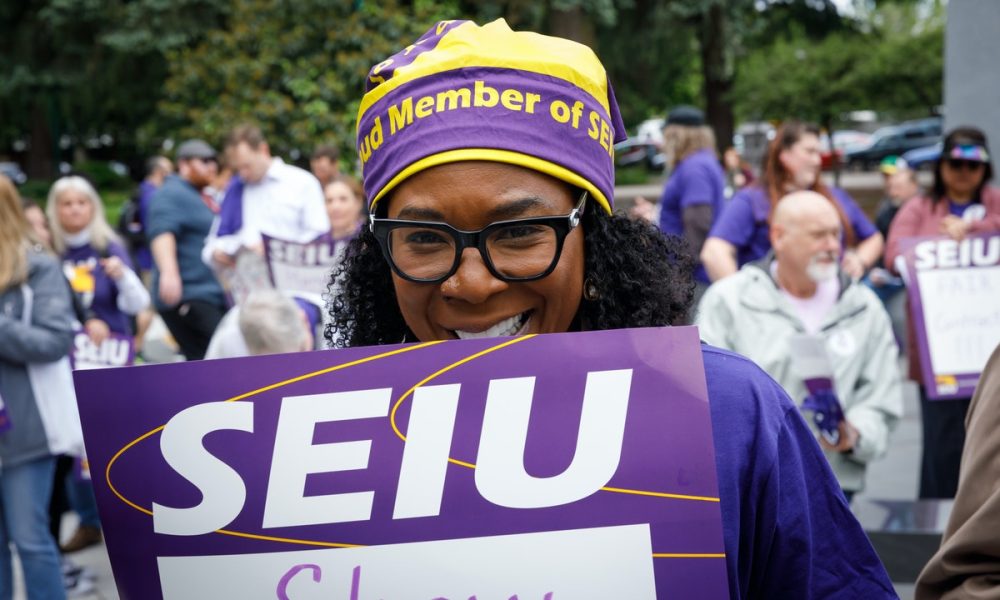 (Courtesy SEUI Local 503)
(Courtesy SEUI Local 503)
SALEM — As thousands of public university workers in Oregon prepare to strike at the end of the month, the union representing them claims there are fundamental problems with how the universities spend money.
A report released Tuesday by SEIU Local 503 is the latest volley ahead of a looming strike by nearly 5,000 classified workers at Oregon’s seven public universities.
In “Misplaced Priorities,” the report’s author, Daniel Morris, contends that more dollars have been flowing toward high salaries for university presidents and top administrators, sports programs and construction financed by borrowing.
The report claims that the state’s public universities have boosted spending in those areas at the expense of classified workers — those who clean, cook and otherwise make the state’s seven universities function.
Those workers are preparing to walk off the job in the midst of an impasse over contract negotiations. The union argues that the proposed cost-of-living increases and pay bumps aren’t enough.
And the union is now publicly questioning whether universities have their spending priorities straight.
For example, in recent years, they claim, universities have been borrowing more and more money to build new facilities.
[ Help build Salem Reporter and local news – SUBSCRIBE ]
In the 1999-2001 budget, 3% of state money given to universities went toward paying down debt, Morris wrote in the report. In the 2017-19 biennium, 16% of state funds allocated toward universities paid debt.
The cause, Morris argues: diminished legislative oversight.
In 2013, lawmakers disbanded the state board of higher education, allowing universities to set up their own independent governing boards.
“This arrangement came with less statewide scrutiny of governance decisions, and more authority for universities to borrow money for capital projects,” Morris wrote.
Capital construction funds are kept separate from other types of funding the university receives, said Di Saunders, a spokeswoman for the universities.
There’s a “strict” ranking system for crucial projects through the Higher Education Coordinating Commission, and building projects stay separate from the operating budget, she said.
And universities received relatively little capital construction funding in the 2019-21 biennial budget, Saunders said.
“I don’t agree that there’s been such a dramatic change in university budgeting since that change did occur,” Saunders said. “There are more expenses that the universities are having to bear than they did not before.”
For example, after the switch, each university needed its own legal help and had to hire internal auditors.
The union also condemns what it calls “administrative bloat,” claiming that there are too many managers.
While Oregon state agencies on average have a management-to-worker ratio of 1 manager for every 10 workers, at public universities it’s 1-to-5.
Saunders, the university spokeswoman, questioned the validity of comparing a university to a state agency. Managers at public universities, she said, have their own duties apart from supervising workers.
But lopsided compensation, with some workers drawing on public benefits, has provoked the ire of the union as well.
In 2018, the average public university president in Oregon made about $513,000, about 11 times what the average classified worker made, according to SEIU’s report. About half of classified workers make less than $40,000 a year.
Meanwhile, the university system has proposed in its contract requiring food service workers to pay $3 for each meal at work instead of $1.
That feels petty, said Melissa Unger, executive director of SEIU Local 503.
“I don’t know how that is making sure that (the universities) meet their bottom line,” Unger said. “That’s a continued example of how this proposal just feels disrespectful and like they’re nickel and diming their workers.”
The universities say they pay their presidents and top administrators a market rate for high-profile jobs managing the education of thousands of students, and for recruiting major donors.
“Those people are running, in some cases, billion-dollar entities,” Saunders said. “They’re high risk entities. You have 30,000 students that you have to educate, protect, make sure that they’re safe, feed, clothe sometimes, make sure their housing is in good order, and so there is a lot of responsibility for those jobs at the top levels.”
Settlement talks are ongoing, and the parties plan to meet again next week.
Reporter Claire Withycombe: [email protected] or 971-304-4148.









